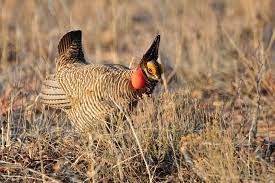
How lesser prairie chicken continues to impact oil production
March 4, 2024
The Journal Record
by Kathryn McNutt
Conservation efforts to preserve the lesser prairie chicken – ongoing for more than two decades – have intensified with the grassland bird’s listing under the Endangered Species Act one year ago.
The U.S. Fish and Wildlife Service listed the bird as “endangered” in part of its current five-state range and “threatened” in the rest effective March 27.
The lesser prairie chicken’s range covers a portion of the oil-rich Permian Basin along the New Mexico-Texas state line – where they are listed as endangered – and extends into parts of Colorado, Kansas and northwest Oklahoma.
Environmentalists have long sought stronger federal protections for the bird, noting it is severely at risk due to oil and gas development, livestock grazing and farming, and the construction of roads and power lines.
Opponents of the listing are “beating the drum of federal overreach,” Wayne Walker, president of Common Ground Capital, said last week while in Oklahoma City to meet with oil industry consultants and executives about the firm’s LPC Conservation land bank program.
“The listing has created a new reality, and as long as it’s around, it will extend that reality,” Walker said.
The energy industry including renewables, oil and gas, and transmission, can count on private conservation for impact mitigation, he said.
The ESA designation prompted a lawsuit filed in U.S. District Court in the Western District of Texas by the Permian Basin Petroleum Association. Three states’ attorneys general joined the lawsuit – Gentner Drummond of Oklahoma, Kris Kobach of Kansas and Ken Paxton of Texas.
In a statement, Drummond said it places burdensome restrictions on Oklahoma ranchers who graze livestock and unnecessarily impedes the development of energy pipelines, oil drilling, wind farms and roads.
Conservation bankers such as LPC Conservation work with private landowners to preserve and restore habitat needed to save species in danger of dying out while allowing essential economic drivers to continue development.
“We’re building habitat strongholds,” Walker said. “It’s a market-based solution. Our credits are available now.”
LPC Conservation has 70,000 acres of suitable habitat under contract and another 40,000 acres approved as conservation credits that can be purchased by developers who need to compensate for unavoidable adverse impacts their projects have on the species, Walker said.
The conservation bank pays ranchers a lump sum to secure acreage that becomes a permanent conservation easement held by a nonprofit land trust that will pay for the management going forward. They can keep ranching but cannot develop the land and often must reduce grazing rates.
LPC Conservation – the only program currently approved by the U.S. Fish and Wildlife Service to sell credits to protect the species’ habitat – has two plans, one for renewable energy and one for oil and gas.
Mostly renewable folks are lining up, Walker said. “A few very large projects have enrolled, and more are coming on board this year.”
The challenge with the oil and gas industry is companies already bought in to state conservation plans, such as the former one administered by the Western Alliance of Fish and Wildlife Agencies.
Walker said the plans were poorly designed, poorly implemented, underfunded and therefore didn’t work. WAFWA did not receive a new required permit following the bird’s listing, so it no longer can cover companies that paid for coverage, he said.
The LPC Conservation plan costs more, but it can get results, Walker said. “It’s a bit of a herd mentality. You get a few on board and others will follow.”
His family has a rancher in Texas’ San Angelo-Ozona area. It does not lie in the lesser prairie chicken range today, but it likely did many years ago, he said.
The species of prairie grouse – known for spring courtship rituals that include flamboyant dances by the males – once numbered in the hundreds of thousands or even millions and inhabited nearly 100 million acres of land, according to the U.S. Fish and Wildlife Service. The population now hovers around 25,000.
It previously was listed as a threatened species in 2014, but the listing was vacated in 2015 following a lawsuit.
The bird needs 25,000 contiguous acres of appropriate habitat to meet its breeding, nesting and brood-rearing needs to thrive. Walker said the goal is to acquire permanent conservation easements from large ranches first and then add on smaller pieces of property adjacent to those.
“We have to have more strategic habitat, connected habitat,” he said. “It’s a big challenge.”
The prairie has lost the buffalo, grizzly bear and wolf, Walker said. “The prairie chicken is the thing to determine if we are going to turn this ecosystem around.”
“The lesser prairie chicken’s decline is a sign our native grasslands and prairies are in peril. These habitats support a diversity of wildlife and are valued for water quality, climate resilience, grazing, hunting, and recreation,” USFWS Southwest Regional Director Amy Lueders said in a statement last spring.
“The Service continues to work with stakeholders to develop voluntary conservation agreements that will protect the lesser prairie chicken and the native grasslands on which it depends while assuring that oil and gas and renewable energy development, ranching, agriculture and other activities continue.”
